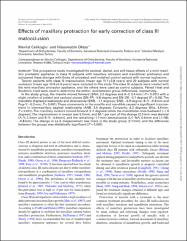| dc.contributor.author | Çelikoğlu, Mevlüt | |
| dc.contributor.author | Oktay, Hüsamettin | |
| dc.date.accessioned | 10.07.201910:49:13 | |
| dc.date.accessioned | 2019-07-10T19:52:38Z | |
| dc.date.available | 10.07.201910:49:13 | |
| dc.date.available | 2019-07-10T19:52:38Z | |
| dc.date.issued | 2014 | en_US |
| dc.identifier.citation | Çelikoğlu, M. ve Oktay, H. (2014). Effects of maxillary protraction for early correction of class III malocclusion. European Journal of Orthodontics, 36(1), 86-92. https://dx.doi.org/10.1093/ejo/cjt006 | en_US |
| dc.identifier.issn | 0141-5387 | |
| dc.identifier.issn | 1460-2210 | |
| dc.identifier.uri | https://dx.doi.org/10.1093/ejo/cjt006 | |
| dc.identifier.uri | https://hdl.handle.net/20.500.12511/2436 | |
| dc.description | WOS: 000330836700012 | en_US |
| dc.description | PubMed ID: 23460730 | en_US |
| dc.description.abstract | This prospective study investigated the skeletal, dental, and soft-tissue effects of a mini maxillary protractor appliance in class III subjects with maxillary retrusion and mandibular protrusion and compared these changes with those of untreated, well matched control sample with normal occlusions. Twenty patients with class III malocclusion (mean age 11.10.8 years) and 20 subjects with normal occlusion (mean age 10.90.4 years) were included to this study. The class III subjects were treated with the mini maxillary protractor appliance, and the others were used as control subjects. Paired t-test and Students t-test were used to determine the within- and between-group differences, respectively. In the study group, the maxilla moved forward (SNA, 2.0 degrees and AY, 2.4mm) (P < 0.001) with a slight rotation of palatal and occlusal planes (SNPP, 0.8 degree and SNOP, 0.7 degree) (P > 0.05). The mandible displaced backwards and downwards (SNB, 1.1 degrees; SND, 0.9 degree; BY, 0.9mm and PogY, 0.3mm; P < 0.001). These movements in the maxilla and mandible caused a significant improvement in intermaxillary sagittal relationship (ANB, 3.0 degrees; Convexity, 6.3 degrees; Wits, 4.6mm; P < 0.001). The maxillary incisors moved forward (2.2 degrees) while the mandibular ones backward (1.9 degrees). The improvement in overjet was 5.0mm, and 66.1 per cent of this change (3.3mm) was skeletal (AY; 2.4mm and BY; 0.9mm), and the remaining (1.7mm) dentoalveolar (U1NA; 0.9mm and L1-NB; 0.8mm). The change in LsE measurement was more in the study group (2.1mm), and the difference between the groups was statistically significant (P < 0.001). | en_US |
| dc.language.iso | eng | en_US |
| dc.publisher | Oxford University Press | en_US |
| dc.rights | info:eu-repo/semantics/openAccess | en_US |
| dc.subject | Malocclusion | en_US |
| dc.subject | Maxillary Protraction | en_US |
| dc.subject | Dental | en_US |
| dc.title | Effects of maxillary protraction for early correction of class III malocclusion | en_US |
| dc.type | article | en_US |
| dc.relation.ispartof | European Journal of Orthodontics | en_US |
| dc.department | İstanbul Medipol Üniversitesi, Diş Hekimliği Fakültesi, Ortodonti Ana Bilim Dalı | en_US |
| dc.authorid | 0000-0001-7862-2983 | en_US |
| dc.identifier.volume | 36 | en_US |
| dc.identifier.issue | 1 | en_US |
| dc.identifier.startpage | 86 | en_US |
| dc.identifier.endpage | 92 | en_US |
| dc.relation.publicationcategory | Makale - Uluslararası Hakemli Dergi - Kurum Öğretim Elemanı | en_US |
| dc.identifier.doi | 10.1093/ejo/cjt006 | en_US |
| dc.identifier.wosquality | Q2 | en_US |
| dc.identifier.scopusquality | Q1 | en_US |


















